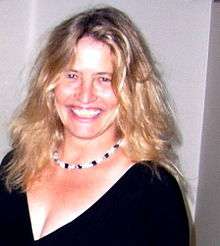Katherine Freese
| Katherine Freese | |
|---|---|
 | |
| Born |
February 10, 1957 (age 59) Freiburg |
| Nationality | United States |
| Fields | Astrophysics, Cosmology |
| Institutions |
University of Michigan Nordita, Stockholm University |
| Alma mater | Princeton, University of Chicago |
| Doctoral advisor | David Schramm |
| Doctoral students | Janna Levin, Mira Franke |
| Known for | Dark matter, Dark stars, Dark energy, Inflation |
| Notable awards | Simons Foundation Fellowship (2012) |
Katherine Freese, a theoretical astrophysicist, is the George Eugene Uhlenbeck Collegiate Professor of Physics at the University of Michigan. Starting in September 2014, she assumed the position of Director of Nordita, the Nordic Institute for Theoretical Physics, in Stockholm, and holds a position as Visiting Professor of Physics at Stockholm University. She is known for her work in theoretical cosmology at the interface of particle physics and astrophysics.
Education and Academic Career
Freese received her BA from Princeton University, her MA from Columbia University, and her PhD in 1984 at the University of Chicago from advisor David Schramm. After postdoctoral fellowships at Harvard University, at the Kavli Institute for Theoretical Physics at University of California, Santa Barbara, and as a Presidential Fellow at the University of California, Berkeley, she became an Assistant Professor at MIT in 1988. She moved to the University of Michigan in 1991. From 2007-2014 she was Associate Director of the Michigan Center for Theoretical Physics.
Contributions
Freese has contributed to early research on dark matter and dark energy. She was one of the first to propose ways to discover dark matter.[1] Her idea of indirect detection in the Earth is being pursued by the IceCube Neutrino Observatory experiment,[2] and the "wind" of dark matter particles felt as the Earth orbits the Milky Way (work with David Spergel) is being searched for in worldwide experiments. Her work decisively ruled out MACHO (Massive compact halo object) dark matter in favor of WIMPs (weakly interacting massive particles).[3] She has proposed a model known as "Cardassian expansion," in which dark energy is replaced with a modification of Einstein's equations.[4] Recently she proposed a new theoretical type of star, called a dark star, powered by dark matter annihilation rather than fusion [5]
Freese has also worked on the beginnings of the universe, including the search for a successful inflationary theory to kick off the Big Bang. Her natural inflation model [6] is a theoretically well-motivated variant of inflation; it uses axionic-type particles to provide the required flat potentials to drive the expansion. In 2013, observations made by the European Space Agency's Planck Satellite show that the framework of natural inflation matches the data.[7] She has studied the Ultimate fate of the universe, including the fate of life in the universe.[8]"
Freese has served on the Board of the Kavli Institute for Theoretical Physics in Santa Barbara and the Board of the Aspen Center for Physics. From 2008-2012 she was a Councilor and Member of the Executive Committee of the American Physical Society, and from 2005-2008 she was a member of the Astronomy and Astrophysics Advisory Committee (AAAC). Currently she serves on the Board of the Oskar Klein Centre for Cosmoparticle Physics in Stockholm. In 2009 Freese was elected Fellow of the American Physical Society. She received a Simons Foundation Fellowship in Theoretical Physics. In September 2012 Freese was awarded an Honorary Doctorate (Honoris Causa) from the University of Stockholm.
Students who obtained their PhD's from Freese include Janna Levin, author and professor in astronomy and physics at Barnard College and Jay Jubas, Senior Partner at McKinsey & Company, Telecoms, Media & Technology.
Personal life
Freese was born in Freiburg, Germany, to Ernst Freese and Elisabeth Bautz Freese. At age nine months she immigrated to the United States. In 1987 she was married to fellow astrophysicist Fred Adams and divorced 10 years later. Their son Douglas Adams is an analyst at Goldman Sachs in NY.
Popular Science
In addition to contributions in academia and research, Dr. Freese has written a comprehensive review for the general educated public on dark matter and energy as they relate to recent research in cosmology and particle physics, titled The Cosmic Cocktail: Three Parts Dark Matter (Science Essentials, 2014, ISBN 0691153353). The book is partly autobiographical. Katherine covers the contributions of Fritz Zwicky, for example, who was recently profiled as "the most important astronomer you've never heard of" and "the father of dark matter" on Cosmos: A Spacetime Odyssey.
References
- ↑ Drukier, Andrzej; Katherine Freese; David Spergel. "Detecting Cold Dark Matter Candidates". Physical Review D. 33 (12): 3495–3508. Bibcode:1986PhRvD..33.3495D. doi:10.1103/PhysRevD.33.3495.
- ↑ Freese, Katherine. "Can Scalar Neutrinos or Massive Dirac Neutrinos be the Missing Mass". Physics Letters. B167 (3): 295–300. Bibcode:1986PhLB..167..295F. doi:10.1016/0370-2693(86)90349-7.
- ↑ James Glanz, New York Times, Feb. 2000, , "In the Dark Matter Wars, WIMPs beat MACHOs",
- ↑ Dennis Overbye, New York Times, Nov. 2003, , "What is Gravity, Really?"
- ↑ Freese, Katherine; Bodenheimer, Peter; Spolyar, Douglas; Gondolo, Paolo. "Stellar Structure of Dark Stars: A First Phase of Stellar Evolution Resulting from Dark Matter Annihilation". The Astrophysical Journal. 685 (2): L101–L104. arXiv:0806.0617
 . Bibcode:2008ApJ...685L.101F. doi:10.1086/592685.
. Bibcode:2008ApJ...685L.101F. doi:10.1086/592685. - ↑ Freese, Katherine; Joshua Frieman; Angela Olinto. "Natural Inflation with Pseudo-Nambu Goldstone Bosons". Physical Review Letters. 65: 3233–3236. Bibcode:1990PhRvL..65.3233F. doi:10.1103/PhysRevLett.65.3233.
- ↑ Collaboration, Planck. "Planck 2013 Results XXII: Constraints on Inflation". arXiv:1303.5082
 . Bibcode:2014A&A...571A..22P. doi:10.1051/0004-6361/201321569.
. Bibcode:2014A&A...571A..22P. doi:10.1051/0004-6361/201321569. - ↑ Philip Ball, , "Never Say Die", New Scientist, Aug. 2002
External links
- Dr. Katherine Freese Home Page from http://www.umich.edu/~ktfreese -or- http://www-personal.umich.edu/~ktfreese
- Video of Katherine Freese on a panel discussion, "State of the Universes," with Jennifer Ouellette, Lawrence Krauss and Neil Turok, at the Quantum to Cosmos festival, October 2009
- Katherine Freese on "The Dark Side of the Universe" panel at The World Science Festival with Elena Aprile, Glennys Farrar, Saul Perlmutter, Michael Turner, and Brian Greene, May 2011